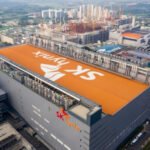An autonomous driving vehicle made with RideFlux’s technology
RideFlux Inc., a South Korean autonomous driving technology startup, has received a temporary permit to operate a driverless car at normal speeds for the first time in the country.
The permit paves the way for the commercialization of Level 4 autonomous driving services, which do not require a safey operator in the front seat, as early as October this year, the Ministry of Land, Infrastructure and Transport said in a statement on Wednesday.
A sports utility vehicle (SUV) equipped with autonomous driving systems and radar sensors, developed by RideFlux, has passed performance and safety tests in the country’s largest autonomous driving pilot zone in Hwaseong, Gyeonggi Province in December last year.
With a temporary license, the vehicle is allowed to drive on a 3.2-kilometer circular section of a road within the autonomous test driving area in Sangam-dong, western Seoul. It can drive at a speed of up to 50 km per hour.
The SUV comes with automatic braking systems for emergency use and maximum speed limit, as well as emergency stop buttons.
Autonomous vehicles that have received temporary operating permits in South Korea are those with a test driver in the driver’s seat, driverless cars driving at an extremely low speed of up to 10km per hour, or special purpose vehicles such as garbage trucks.
RideFlux launched autonomous driving service in Jeju Island, Korea in May 2024
The unmanned vehicle will undergo additional safety verification tests in two stages before its commercialization, which would take place under limited conditions, such as driving only in the designated areas where the performance tests are carried out.
“If the driverless vehicle passes additional safety tests at one time, it will be able to start commercial services as early as October,” the ministry added.
The first stage of autonomous driving test will be conducted with a test driver seated in the driver’s seat.
For the second-stage test, the vehicle will be operated without a safety operator in the front seat. Instead, a safety operator must be ready to take emergency measures through remote control inside or outside the car.
As the demand for autonomous driving services is expected to rise, the transport ministry plans to develop standards in detail by the end of this year for issuing temporary autonomous driving permits.
By In-Hyeok Lee and Kang-Ho Jang
twopeople@hankyung.com
Yeonhee Kim edited this article















